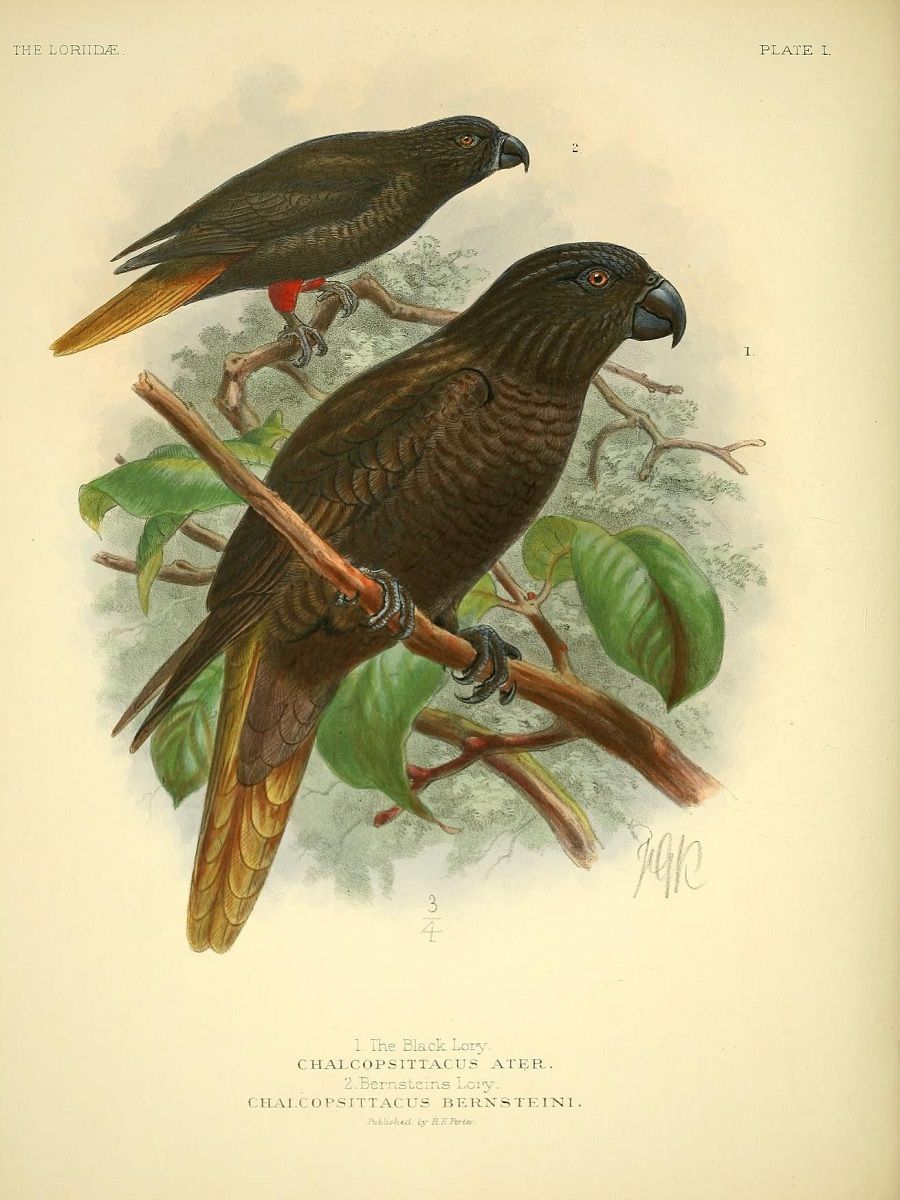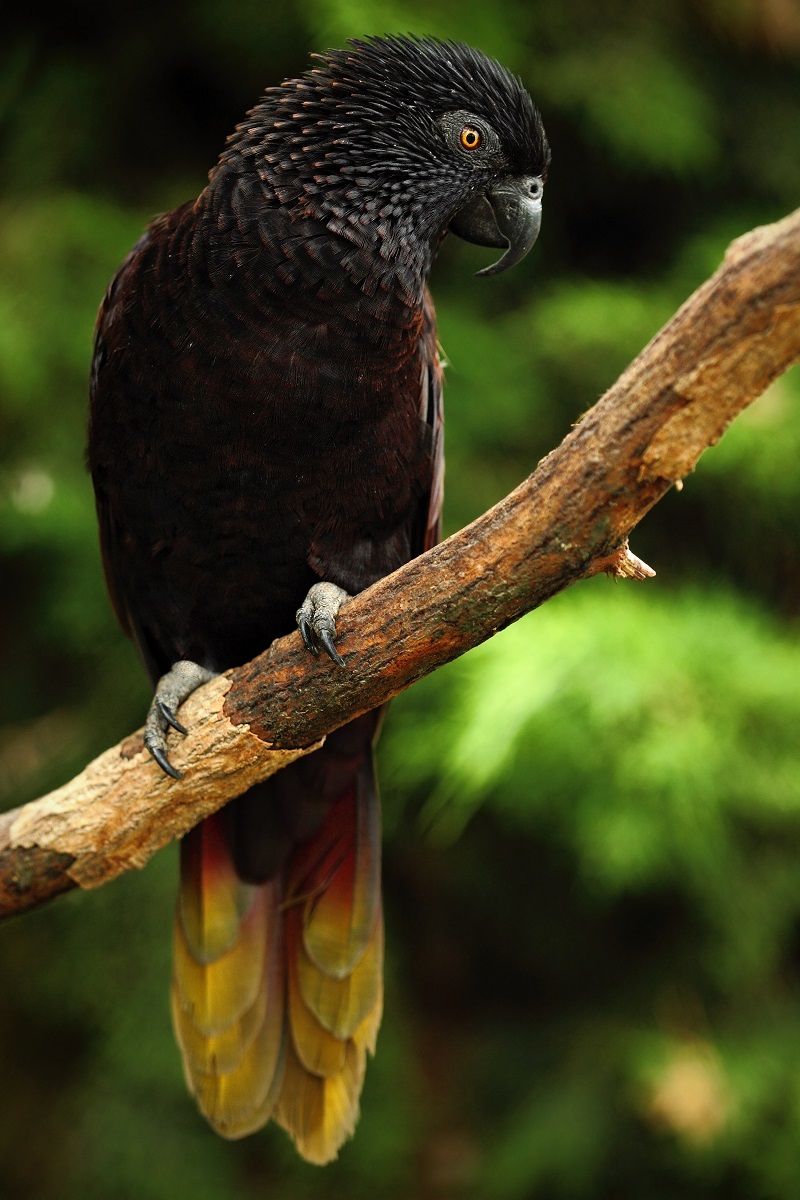The black lory, native to Indonesia, is one of the most striking parrots out there. Although it’s many a parrot lover’s dream species to own, as of right now, it’s not very commonly seen in aviculture yet.
Below, let’s have a look at everything you need to know about this stunning lory, from its natural habitat to its diet and how to care for it.
| Name(s) (common, scientific) | Black lory, rajah lory, red-quilled lory, Chalcopsitta atra |
| Natural habitat | Indonesian rainforest |
| Adult size | Up to 32 cm (12.5″) and 260 grams |
| Lifespan | 20-30 years |
| Noise level | High |
Black lory appearance
The black lory is a beautiful parrot to look at. What stands out most, of course, is its color: a very shiny dark brown to black, with orange-yellow tail feathers.
All three subspecies have a black beak and reddish-brown eyes. They’re similar in size (up to 32 cm/12.5″ long and weighing 260 grams), but there are a few notable differences that help tell them apart:
- Chalcopsitta atra atra: Rarely any red coloring aside from on the tail
- Chalcopsitta atra insignis: Mottled red on legs, head, underwings and breast
- Chalcopsitta atra bernsteini: Reddish markings on forehead and legs
Apparently, a fourth subspecies has been named, but has not been recognized because the specimen it’s based on is thought to be a hybrid. Chalcopsitta atra can interbreed with the closely related Chalcopsitta scintillata (the yellow-streaked lory), and this does appear to happen in the wild sometimes.
Juvenile black lories can be told apart from the adults by the white skin around their eyes, which turns black as they age.
It’s unfortunately not really possible to tell the difference between a male and a female black lory. If you have one and don’t know its sex, a DNA test can help clarify things.
Did you know? Researchers have found that the black lory is one of the few bird species that has dark feathers that reflect UV light – normally it’s mostly colorful feathers that do so. Birds can see this light wavelength, and the UV-reflecting feathers are thought to help them select a mate.
Mullen & Pohland, 2007


Black lory range & natural habitat
Range
The black lory is naturally found in the Asian island nation of Indonesia.
Populations exist in the Bird’s Head and Bird’s Beak peninsulas and surrounding islands (Southwest and West Papua), as well as on the nearby island of Misool.
Natural habitat
The islands these birds naturally inhabit are mostly covered in tropical rainforest, but the black lory prefers their more open parts. It’s mostly seen in areas with lighter tree cover, like forest edges, savannah-like zones, palm plantations, and swamp or mangrove forests.
In the wild, this species can usually be found in large flocks that forage together.
Threat level
As of 2016, the IUCN Red List has assessed the black lory to be a species of Least Concern. It notes that the species has a very wide range and that the population size appears to be stable.
Tip: Don’t confuse the black lory (Chalcopsitta atra) with the black-capped lory (Lorius lory) or the black-winged lory (Eos cyanogenia). Their names may be similar, but they’re completely different birds!

Black lory diet
In the wild
Like other lories (and their lorikeet cousins), the black lory is quite specific about its diet. It has evolved specifically to eat nectar and soft fruits, using its funky brush-tipped tongue to reach deep into flowers and find the good stuff.
There isn’t all that much known about the specific flowers and fruits that black lories eat in the wild. Sources do mention that they congregate in flowering trees and shrubs like Schefflera.
In captivity
Lories are not recommended as pets for beginning parrot enthusiasts. Their complicated diet is the main reason: as you can imagine, feeding a liquid nectar diet isn’t as straightforward as seeds and pellets are.
First off, there’s the poop issue. A liquid diet means liquid poops, so most lory owners actually find themselves hanging shower curtains behind their birds’ cages to deal with the spray. Yikes!
Secondly, and more importantly, is the fact that it’s easy to get it wrong. Because their digestive tracts are different, lories like the black lory are more sensitive. For example, they’re prone to hemochromatosis as a result of excess iron. The same can happen with vitamin C.
If you do keep a black lory, it’s very important to choose a high-quality nectar brand to use as a staple (up to 90% of daily meals). Not all the foods for sale are actually good for them! Pick something that doesn’t surpass 50-100 ppm iron. A sugar content of 20-25% is recommended.
You can supplement your bird’s diet with fresh fruits and some fresh vegetables, but be sure to pick ones that aren’t high in iron (like apricots or prunes) or in vitamin C (like strawberries).
Tip: The Arizona Exotic Animal Hospital has an excellent chart of fruit iron and vitamin C contents. It also recommends testing the iron content of your well water and using bottled if it’s too high.
Black lory as a pet
If you have some experience with parrots and have managed to found someone who breeds black lories, you can consider keeping one as a pet. They’re not just beautiful, they’re fun too – if you’re into the crazy type of fun.
Lories, including the black lory, are the clowns of the bird world. They don’t have an “Off” button and love to play, fly, jump, explore and generally bounce around the house.
Most black lories are easy to socialize. They’re known for being gentle and love to hang out with their owners.
Housing
Your pet black lory will require a large cage decorated with plenty of fun and colorful parrot toys. It should contain natural wood perches and multiple food and water stations.
Enrichment
Lories get bored quickly, maybe even more quickly than other parrot species. It’s important to keep yours busy to prevent stress, which can lead to issues like feather plucking, excessive screaming and even aggression.
Here are some things you can do:
- Spend a lot of time with your lory. That means hanging out, training, singing, dancing, anything you can think of!
- If you work a regular 9-5, you should consider getting your bird a friend. They’re extremely social beings.
- Provide plenty of normal parrot toys and foraging toys to stimulate your bird’s smart brain. Chewing and destroying stuff is truly their calling in life.
- Let your black lory out of its cage for multiple hours a day. You can get it a parrot playground to hang out on while it’s out.
Tip: don’t forget to keep safety in mind. Our curious feasthered friends are prone to hurting themselves! You should know how to parrot-proof a space and provide basic parrot emergency care.

Black lory sounds
Although it’s not the loudest lory of them all, the black lory does have a very shrill call. If you’d like to keep one, it’s important to very seriously consider whether you can handle the noise.
The species’ call is described as a repeated screech or chitter. You can have a listen at xeno-canto if you’re curious.
Like other lories, the black lory can learn to repeat some tunes, words and simple phrases. They don’t have the clearest voices, but talking training can nonetheless be a fun bonding activity for you and your bird.
If you have any more questions about the black lory or if you’d like to share your own experiences with this striking parrot species, don’t hesitate to leave a comment below!
Sources & further reading
- Gelis, S. (2011). A review of the nutrition of lories and lorikeets. In Proceedings of AVES International Parrot Convention.
- Mullen, P., & Pohland, G. (2008). Studies on UV reflection in feathers of some 1000 bird species: are UV peaks in feathers correlated with violet‐sensitive and ultraviolet‐sensitive cones?. Ibis, 150(1), 59-68.
- Parr, M., & Juniper, T. (2010). Parrots: a guide to parrots of the world. Bloomsbury Publishing.
- West, G. D., Garner, M. M., & Talcott, P. A. (2001). Hemochromatosis in several species of lories with high dietary iron. Journal of Avian Medicine and Surgery, 297-301.
